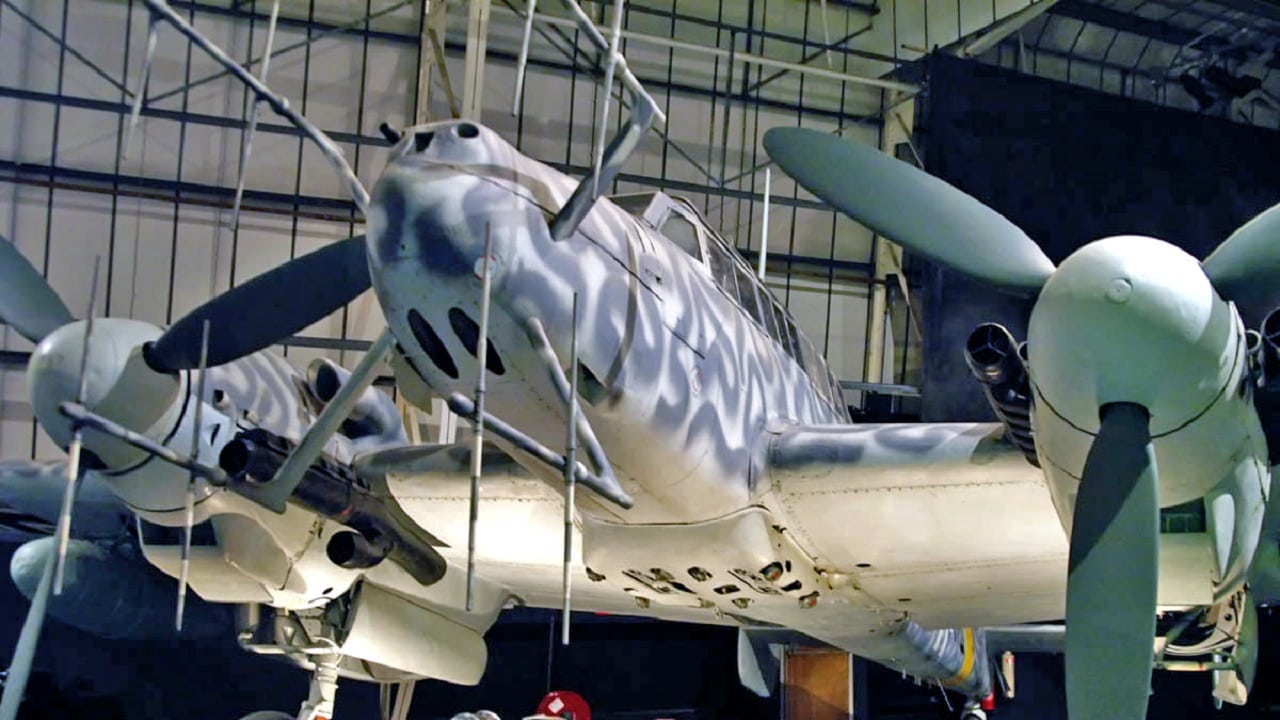When one thinks of twin-engine, piston-driven (in other words, propellers as opposed to jet engines) fighter planes of the Second World War, chances are the good ol’ American-made Lockheed P-38 Lightning comes to mind. And understandably so, as it was flown by the top two U.S. aces of the war.
But Nazi Germany’s Luftwaffe had its own deadly twin-engine fighter that “got there first” (in chronological timing relative to the P-38, that is). That warbird is our current subject, the Messerschmitt Bf 110.
Messerschmitt Bf 110 Early History and Specifications
The Bf 110 (ofttimes erroneously called the “Me 110”) made its maiden flight on May 12, 1936, and officially entered into operational service with the Vaterland (“Fatherland”) the following year. The plane was built by Messerschmitt Aktiengesellschaft (AG; “Corporation”), which was named for founder Wily Messerschmitt and arguably the most famous German aircraft manufacturer of WWII (practically to the point of being generic in terms of name recognition).
The plane was trumped up by Hermann Göring – commander-in-chief of the Luftwaffe and Hitler’s second-in-command of the Third Reich – to be the Luftwaffe’s premiere offensive fighter plane, due to its combination of speed, range, and heavy armament. Though the reality of the Bf 110 didn’t quite work out the way Herr Göring had envisioned, however, the plane did prove itself to be quite versatile, serving as a Nachtjäger (night fighter), Jagdbomber/Jabo (fighter-bomber), and Zerstörer (destroyer/heavy fighter).
Specifications included a crew of two of three – pilot, rear gunner, and radio operator (a distinct differentiator from the aforementioned P-38 Lightning, which was a single-seater). The airframe had a fuselage length of 39 feet 7.25 inches, a wingspan of 53 feet 3.75 inches, a height of 13 feet 6.5 inches, an empty weight of 9,755 pounds, and a maximum takeoff weight of 14,880 pounds. Max airspeed was 336 miles per hour, with an operational range of 591 nautical miles and a service ceiling of 32,810 feet. The armament consisted of two 20mm FF cannons, four 7.92mm MG-17 machine guns, and one 7.92mm MG-15 machine gun for rear defense.
Operational Performance
The plane was first “blooded” in combat at the start of WWII during the September 1939 blitzkrieg (“lightning war”) against Poland and acquitted itself very well, with one unit garnering 30 air-to-air kills against Polish fighters on the first day of the bombing of Warsaw. It also performed well in the Norway and France campaigns of 1940.
During the Battle of Britain, however, the Bf 110, when flying daytime close escort for German bombers, started showing its weaknesses in the criterion of agility, and became easy pickings for the Royal Air Force’s (RAF’s) single-engine Supermarine Spitfires and Hawker Hurricanes, incurring grievous losses in the process, including no less than Hermann Göring’s own nephew, Hans-Joachim Göring.
The warbird fared much better in the Nachtjäger role. Indeed, when HistoryNet contributing editor Stephan Wilkinson did his August 2019 writeup on the plane, he chose the title “How the Me-110 Became a Bomber’s Worst Nightmare,” accompanied by the headline blurb “it went on to become World War II’s most successful night fighter.” (We’ll give Stephan a free pass for using the label “Me-110” as opposed to “Bf 110.”).
Particularly noteworthy is the fact the highest-scoring night fighter ace of all time, Major Heinz-Wolfgang Schnaufer (1922-1950), flew the 110 exclusively, racking up 121 kills in 164 sorties between June 1942 and March 1945, including two separate instances of attaining ace-in-a-day status. i.e., five aerial victories in a single day.
Mr. Wilkinson notes how Maj. Schnaufer “shot down seven Lancasters in a single night and then simply quit. ‘They seemed to be lining up to be shot down,’ he said. ‘I just had to stop after the seventh one. I was tired of the killing.’ It was effectively the 110’s swan song, with the war in Europe ending less than three months later … At one point, the victory-to-loss ratio was 30 RAF bombers downed for every Me-110 lost.”
The Bf 110 also dished out its fair share of punishment against U.S. daytime bombers like the B-17, particularly during the infamous Eighth Air Force bombing raid on the Schweinfurt ball-bearing plants in October 1943.
Where Are They Now?
Out of 6,170 Bf 110s built, two completely original intact aircraft are known to have survived. One – a G4 (or G2, depending on which source you believe) variant bearing serial number 730301 – is at the RAF Museum London; I personally visited this museum back in 2017 and highly recommend it to my fellow aviation history buffs. The other – an F-2 variant with serial number 5052 – is housed at the Deutsches Technikmuseum (German Museum of Technology) in Berlin.
According to Wilkinson, “A third, displayed as an Me-110G-4, is owned by a Danish group in Gilleleje, about 40 miles north of Copenhagen. It is actually a restored assemblage of parts from a variety of 110s.”
Christian D. Orr is a Senior Defense Editor for 19FortyFive. He is a former Air Force Security Forces officer, Federal law enforcement officer, and private military contractor (with assignments worked in Iraq, the United Arab Emirates, Kosovo, Japan, Germany, and the Pentagon). Chris holds a B.A. in International Relations from the University of Southern California (USC) and an M.A. in Intelligence Studies (concentration in Terrorism Studies) from American Military University (AMU). He has also been published in The Daily Torch and The Journal of Intelligence and Cyber Security. Last but not least, he is a Companion of the Order of the Naval Order of the United States (NOUS).

